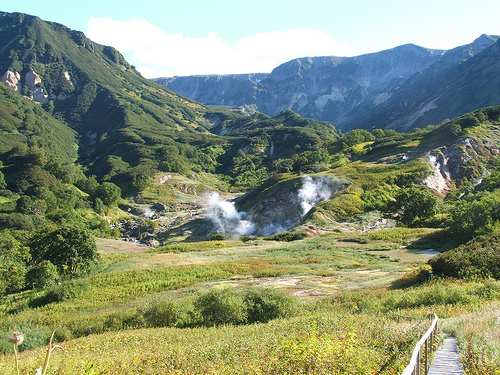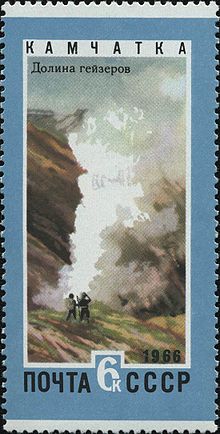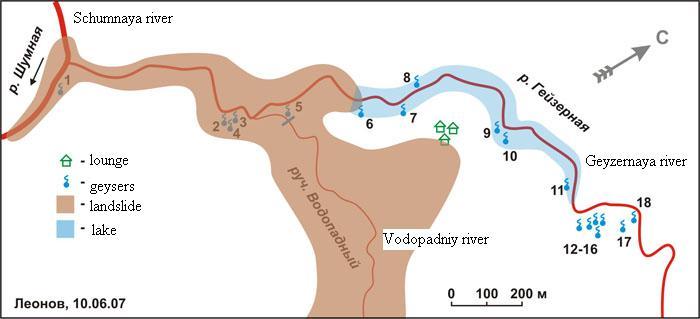

Location: Kamchatka Peninsula Map

Valley of Geysers is located in Kamchatka Peninsula in the Far East Region of Russia. It is a fairly small valley with numerous geysers that spew hot water to various heights and at various time interval. The cause for such active geologic processes is a volcanically active fault of the Pacific plate and East Siberian plate. Valley of Geysers is a marvelous valley located in Kronotsky Nature Reserve in the mountains of the Eastern volcanic belt. The geological formation is a former lake that disappeared centuries ago. It covers an area of 7 square miles that includes over 20 geysers, each with a different name. They all range in size and period of activity. Some shoot boiling water every 10- 12 minutes while other erupt once in 4- 5 hours. The best time to visit the valley is from June till September months. Although some prefer to risk bad weather in order to see peculiar combination of snow and fountains of hot water shooting from the ground.

1. Pervenec (first order)
2. Troynoy (triple geyzer)
3.
Sacharniy (sugary)
7. Konus (cone)
9. Maliy (minor)
10.
Bolschoy (major)
11. Schel' (crevice)
12- 16. Vitrazh (stained
glass)
17. Velikan (giant)
Valley of Geysers is one of the greatest geographical discoveries of the twentieth century. In 1941 Tatyana Ustinova, Kronotsky geologist with the help of an explorer Anisifor Krupenin were conducting the study of the region. Their goal was to find out why some of the rivers in the region are warmer than the others. During one of the breaks jet of boiling water suddenly startled the travelers. It was the geyser that became later known as Pervenec (First order or First born) in reference that it was the first such formation found in the valley.
Geographical position
The Valley of Geysers is
located in the Kamchatka Territory of the Russian Federation.
Spatially, it is located within the Eastern Ridge, in the deeply
eroded southeastern part of the Uzon-Geysernaya caldera, which is
part of the Geysernaya River basin, a tributary of the Shumnaya
River.
general characteristics
There are three separate
groups of thermal springs in the Geysernaya river valley:
Kikhpinychevskaya group - at the source of the river, on the slopes
of the Kikhpinych volcano, with thermal springs of acid composition
and low flow rate, and with fumaroles;
Upper geyser group - in a
section of the river with a southeastern strike, with active
fumarolic activity;
The Geyser group itself is located on a
section of the river in its lower reaches, where the bulk of thermal
springs and all geysers are concentrated. It is usually called the
Valley of Geysers.
This group of springs is located in the lower
reaches of the Geysernaya River, near its confluence with the
Shumnaya River, on a section with a total length of about 2.5 km.
There are 20 large geysers and several hundred outlets of thermal
waters coming out in the lower part of the canyon about 400-500 m
deep, in the riverbed and at the bottom of Lake Geysernoe, from
which almost boiling water flows, the temperature of which exceeds
95 ° C and hot steam jets.
Currently, about two-thirds of the
valley is covered by a major 2007 landslide.
History
Valley discovery
The Valley of Geysers was discovered in April
1941 by Tatiana Ustinova, a geologist at the Kronotsky Reserve, and
Anisifor Krupenin, an Itelmen guide.
“In April 1941, together
with an observer of the reserve, a Kamchatka aborigine Anisifor
Pavlovich Krupenin, I went on a dog sled - a transport that had
already passed into the past - to look for where the water from the
Uzon volcano caldera went. I visited Uzon with my husband, zoologist
Yuri Viktorovich Averin, in 1940, the year of our arrival in
Kamchatka and the beginning of work in the Kronotsky reserve.
Tatiana Ustinova "
The time of the study - April - was not
chosen by chance, since the expedition was supposed to be on dog
sleds, and at this time of the year there is still a lot of snow on
the territory of the Kronotsky Nature Reserve, which covers thickets
of bushes that are impenetrable in summer. We ascended along the
mouth of the Shumnaya River. The border of the reserve then passed
along it. On the diagram, it had no tributaries, but Tatyana
Ustinova suggested that the river should have a left tributary
carrying water from the Uzon:
“The water in Shumnaya had an
iridescent hue that is difficult to describe. It occurs in pure
fresh water if it is mixed with a significant amount of mineral.
This strengthened my assumptions ... and at the end of the day we
saw a large left tributary flowing into the Shumnaya from the Uzon
side, as I expected.
Tatiana Ustinova "
Tatyana Ustinova
and Anisifor Krupenin decided to explore this tributary and hoped to
reach the river flowing from the caldera of the Uzon volcano, thus
the discovery of the geyser Valley in Kamchatka was a matter of
chance, especially since no one had ever found geysers on the Asian
continent before, they were known at that moment only in three
places of the globe: in Iceland, USA and New Zealand. Despite the
fact that there are many volcanic areas, there are few geysers,
since their appearance requires rarely met thermodynamic conditions.
“The weather was excellent ... Getting up early, we got dressed,
or rather undressed for the weather: tunics, kamleys - knee-length
white shirts made of tent fabric that protect from wind and snow,
put on high rubber boots, took skis and set off to explore the found
tributary of Shumnaya ... got on their skis and ran briskly up the
river. Soon the skis had to be abandoned ... and then we went along
the snow-covered slope, falling to the knees ... We walked, walked,
but there was still no river from Uzon. But you still have to go
back, get out of the valley. While they were pondering, a tall
column of steam flew up ahead, apparently there was a large hot
spring. We decided to reach him all the same. The weather is getting
worse, we are going, but there is no hot spring, the camp is getting
farther ... They don’t joke with the weather in the mountains, we
decided to go back. We sat down in the snow to rest, eat what we
took with us. Suddenly, from a small floating platform on the
opposite bank ... a slanting stream of boiling water hit us,
accompanied by clouds of steam and an underground rumble ... We were
terribly frightened, huddled together, sat and did not know what
awaited us. The behavior of volcanoes is unpredictable ... And
suddenly the eruption of boiling water stopped, for some time the
emission of steam clouds continued, and then everything calmed down
and in front of us lay a small floating platform, unremarkable. Then
I came to my senses and yelled in a voice that was not my own:
"Geyser !!!"
Tatiana Ustinova "
Due to weather conditions, further movement along
the river basin was impossible, and the researchers decided to
return to the camp to the cordon, and then back to the village. But
Tatiana was eager to continue exploring the newly opened geyser, now
together with her husband and the then director of the reserve:
“In Kronoki, I told my husband and the director about my
discovery, and we unanimously decided that in the summer we should
go to explore the warm river we found. But in the summer the
director left for Moscow, Averin stayed for the director and could
not leave the village. In July 1941, we set off again together with
Krupenin with one pack horse, which was carrying our camp equipment
and a few supplies.
Tatiana Ustinova "
The second time we
went along a different path, first along the coastal lowland, then,
climbed into the high-mountainous desert, bypassed the cone of the
Krashennikov volcano, then past Savich's cone and “... came to a
cliff into a deep valley. It had many streams of steam that littered
its bottom and slopes. From time to time fountains of boiling water
- geysers - exploded in different places. " So Tatyana Ustinova and
Anisifor Krupenin visited the valley for the second time, now for 4
whole days with the goal of direct research and description of this
natural object.
“We walked around the entire active section
of the valley, described all the geysers found, timed the stages of
their activity and gave them names, not perpetuating each other with
them, but for reasonable reasons. The largest geyser is the Giant.
Geyser gushing from the gap - the Gap. Geyser, which during
eruptions water beats from three holes - Triple. The firstborn we
found in the spring. It was interesting to work, but also scary. We
did not know the mode of the sources. At any moment, a stream of
boiling water could splash on us from the slope along which we were
passing ... It turned out that in the tent under the sleeping bags
the soil, cold to the touch, warmed up so that we slept like on a
stove, and a few meters from our tent a grazing horse suddenly fell
through with its hind legs, and steam rose from the holes formed all
the time we were in the valley.
Tatiana Ustinova "
Returning to the reserve base, Tatyana Ustinova talks about her
achievements and her husband, Averin, who was then replacing the
director, sends a telegram to the Reserve Department in Moscow. But,
in connection with the outbreak of the war, in a return telegram,
scientific work was ordered to stop, Ustinov to be fired, to finally
appoint Averin in the place of director, to observe the strictest
economy. Thus, the exploration of the valley was suspended until the
end of the war.
Tatyana Ustinova had a chance to visit the
valley again after the end of the war. This trip was made by three:
Averin, Krupenin and Ustinova. This time a detailed diagram was
made, descriptions, photographs, water samples were taken.
Tourism
Both in Soviet times and after 1991, the Valley of
Geysers was one of the most visited places in Kamchatka. The Valley
of Geysers is also part of the Volcanoes of Kamchatka UNESCO World
Heritage Site.
Since 1967, "wild" tourism has been banned in
the Valley of Geysers, and since 1977 - tourism in general.
In 1993, after creating the necessary infrastructure, the valley was
reopened for tourists. More than three thousand people came to the
valley a year.
The independent access of tourists to the
Valley of Geysers is strictly limited.
In 2007, the head of
the Federal Agency for Tourism Vladimir Strzhalkovsky asked Russian
President Vladimir Putin to increase the quota for tourists visiting
the site, to which he received the answer: "This decision should be
based solely on the opinion of experts," which the press interpreted
as a refusal.
Events
Typhoon Elsa 1981
In 1981, typhoon
Elsa caused rains, due to which the water level in the Geysernaya
River rose by several meters. Mud streams carried along the channel
three-meter boulders, destroying everything in their path. Many
springs have suffered, including the famous Malachite Grotto. The
Big Stove Geyser has disappeared.
Landslide 2007
On June 3, 2007, a major geological catastrophe
occurred in the Valley of Geysers - a giant landslide descended,
forming a powerful mudflow that blocked the Geysernaya river bed
with a dam. The total volume of collapsed rocks is estimated at
about 20 million m³.
On this day, at 14:20 local time, a huge
landslide descended in the upper reaches of the Vodopadny stream,
accompanied by a powerful mud-stone flow. It fell down the valley of
the Vodopadny stream towards the Geysernaya river. In the process, a
mudflow was formed from the heavily watered mud-stone mass, which
quickly reached the Geysernaya river channel and, having formed a
high dam, rushed down the Geysernaya channel, stopping only at the
Triumphal Gates. At the same time, during the second phase of the
geological cataclysm, the collapse of landslide ledges in the upper
reaches of the Geyserny stream continued, as a result of which
anhydrous debris avalanches were formed that descended along the
landslide body, completing the formation of the dam. One of the
tongues of debris avalanches stopped a few meters from the helipad
and the visitor center of the reserve.
The victims were
avoided - the tourists and personnel who were in the valley were not
injured, they were urgently evacuated. From June 3 to July 20, the
Valley of Geysers was closed to tourists. During this time, two
helipads and excursion trails were restored.
In the upper
reaches of the Vodopadny stream, a single amphitheater of collapse
was formed with a breakaway ledge up to 150 meters high, the length
of landslide and mudflow masses was 1.7 km with a width of 200-400
meters. The landslide massif, which reached the Geysernaya river
canyon, formed a high rock-fill dam with a height of about 50 - 60
meters, which blocked the river. All the following days, the dammed
lake was growing and many unique objects of the Valley of Geysers
were inundated. On June 7, the level of the lake reached its maximum
level, many geysers were flooded, including the Bolshoi, when in the
evening at 19:30 water overflow began over the dam. During the
breakthrough of the dam within 4 hours, the level of the lake
dropped by 9 meters.
On June 6, 2007, the head of the Russian
Ministry of Natural Resources, Yuri Trutnev, announced that the
state would take all possible measures to preserve the natural
monument. At the same time, he admitted that the Valley of Geysers
would no longer exist in its former form.
On July 30, 2007,
20 large and medium-sized geysers out of forty-two functioned. 13
geysers, including the Bolshoi geyser, were located under the water
of the lake, which was formed as a result of the closure of the
Geysernaya river by a mudflow.
On September 20, 2007, the
Bolshoi geyser came to life in the Valley, which had been under
water for about three months, and it works in almost the same way as
before the mudflow to the Valley on June 3.
According to the
Minister of Natural Resources of the Kamchatka Territory, Yuri
Garashchenko, dated May 14, 2008, all springs, except for the Maly
geyser, operate in a normal or close to normal mode, and the
situation in the Valley has stabilized. The small geyser is still
under a 5-7 meter layer of water, but it manifests its activity in
the form of a heat flow.
Other events
Self-healing in 2013
In September 2013, a new mudflow restored geysers and increased
their number.
Landslide 2014
A major landslide occurred on
January 4, 2014.